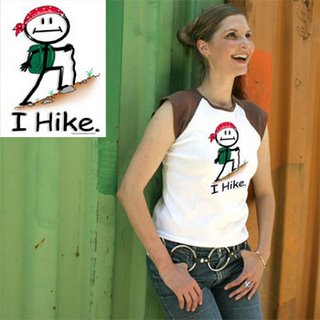
It is first necessary to assess the type of backpacking trip that you will be taking: What will your elevation be (high elevation=cold/snow)? What time of the year will you be going? What is the weather forecast? That last question can be a bugger. There are always those rare occasions when an unforcasted storm can roll through, but as a general rule, you can get prepared for a trip based on the immediate forecast. Later on I'll mention some items that are handy to have along for those surprise storms. Now that you know what to expect from the elements, you can dress based on whether you trip will be a cold one, a hot one, or a little of both.
Cold weather backpacking trips require a developed clothing system known as
"layering." You can check my articles section out for more in depth info on layering. Layering is just that. You layer your clothes, typically 3 layers, so that you can better manage your body's heating and cooling system. Your first layer should almost always be a long, thin, synthetic layer. Synthetic materials wick or pull moisture away from your body to keep your skin warm and dry. Polypropylene works great as it is typically the least expensive and dries faster than any other material. Leave the cotton at home. Cotton gets wet and stays wet. The middle layer should be an insulating layer. Synthetic or wool (especially merino wool) works great here. In general, the more air your clothing traps inside the warmer it will be. Finally, the outer layer should be windproof and breathable. It should also be waterproof and breathable if you are expecting some rain. In some follow ups to this post, I will list some great layering systems including brands that I would recommend. So, this will pretty much cover you for a cold weather trip. See future posts below for Accessories to wear such as socks, hats, gloves, etc.
Now, if you are planning on hot weather, you can skip the long underwear layer. If you're a lady, you'll need to look into a nice wicking sports bra that breathes well. There are assortments of them nowadays since there has been such a push for athletic clothing manufacturers to make athletic clothing that actually fits a woman. Women no longer have to improvise with men's stuff that altogether fits wrong. Synthetic, wicking briefs are a must for men. There is nothing as uncomfortable as cotton briefs that stay wet your whole trip. Some men and women, for that matter, prefer boxer style briefs. I personally don't like them due to the tendency for them to ride or bunch up. But, that's just my own preference. Not too long ago,
producing their capilene material in the form of a thong for those ladies who like to floss. Anyway, the point is, wear as little as possible against your skin, and what you do wear should wick well and dry quickly.
The next layer should be light weight and breathable. A nice athletic t-shirt made of polyester works great. If you prefer to stay out of the sun, loose fitting long sleeve shirts are also available in polyester or similar synthetic fabrics. I can't stress enough just how important fast drying, synthetic fabrics are for outdoor activities. When you finish hiking and start making camp, the last thing you want is the discomfort of all that cold wet cotton garbage clinging too you. Trust me on this one. In fact, one way to tell if fellow packers are newbies is by their apparel. Cotton = Newbie, Synthetic = Veteran (or well informed newbie cloaked as a veteran). You get my point. For hot weather, your pants can vary. There are so many products out there that you really just need to stick to lightweight and breathable and you'll be fine. By this time, I no longer need to add "quick drying" and "synthetic" to the description. Shorts work great for backpacking, but you might prefer long pants to save your legs from scratchy brush. I always were a pair of zip-off long pants so that I can make that decision on the trail.
You're all set! Stick to these basics and you'll be a happy backpacker. I'll get some more posts on here about backpacking accessories as soon as I get a chance. The good thing about most of this gear is that it is interchangable with other outdoor activities. So, once you buy your backpacking thermals, you also have your ski thermals, your snowshoeing thermals, your snow camping thermals, and so on. The key is just to get them in the right materials. Please post comments if you think I left something out that you feel is vital or otherwise important. Also, I guess I forgot to mention the handy extras to take along "just in case," so I'll add those in another post.